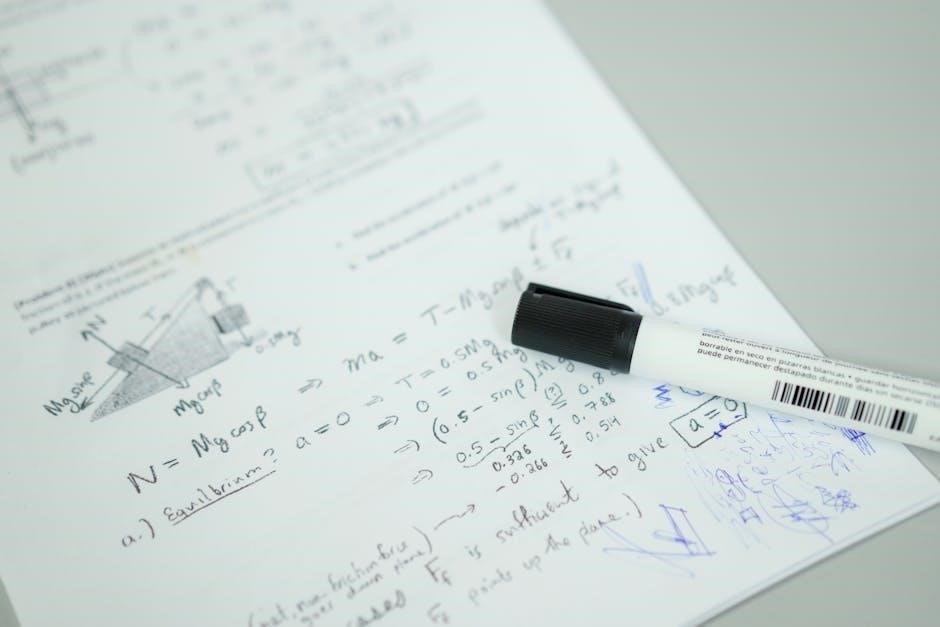Geometry basics form the foundation of understanding spatial relationships, starting with points, lines, and planes. Originating from Greek words, it literally means “earth measurement,” evolving into a crucial field for problem-solving and critical thinking. This unit introduces fundamental concepts, essential for modern education and real-world applications, supported by study guides and answer keys for effective test preparation.
Definition and Origin of Geometry
Geometry, derived from the Greek words “geo” (earth) and “metry” (measurement), is the study of shapes, sizes, and positions of objects. Originating in ancient civilizations, it was initially used for practical purposes like surveying and construction. Over time, geometry evolved into a theoretical field, with contributions from mathematicians across history. Its definition has broadened to encompass the analysis of spatial relationships, dimensions, and properties of figures. Understanding geometry’s origin and definition is crucial for grasping its fundamental concepts, such as points, lines, and planes, which are essential for problem-solving and critical thinking. This foundation is key to excelling in geometry basics and preparing for unit 1 tests effectively.
Importance of Geometry in Modern Education
Geometry is a cornerstone of modern education, fostering critical thinking, problem-solving, and spatial reasoning skills. It is essential for understanding real-world applications in fields like architecture, engineering, and physics. By mastering geometric concepts, students develop analytical abilities and logical reasoning, which are vital for academic and professional success. Geometry basics, such as points, lines, and planes, form the foundation for advanced mathematical studies. Inclusion of geometry in curricula ensures students are prepared for challenges in science, technology, and design; Effective learning resources, like unit 1 test study guides and answer keys, help students grasp these concepts, making geometry a vital component of modern education and lifelong learning.
Overview of Unit 1 Test Structure
The Unit 1 test assesses foundational geometry concepts, focusing on points, lines, and planes. It includes multiple-choice and free-response questions, evaluating understanding and problem-solving skills. The test structure is designed to measure mastery of basic principles, ensuring students can apply geometric concepts to various scenarios. Time management is crucial, as the format requires concise and accurate responses. The test aligns with study guides and answer keys, providing a clear framework for preparation. By understanding the test structure, students can prioritize their study efforts and approach the exam with confidence. Effective preparation involves practicing with sample questions and reviewing key formulas and theorems to ensure readiness for the assessment.

Key Concepts in Geometry Basics
Key concepts include points, lines, planes, and dimensions, forming the foundation of geometry. Essential formulas and theorems, such as the Pythagorean theorem, are introduced to solve problems. Diagrams and visual aids help students understand spatial relationships and shapes, while practice problems reinforce understanding. These concepts are critical for building a strong foundation in geometry and preparing for unit tests. Mastery of these basics enables students to approach more complex topics with confidence and accuracy, ensuring success in geometry and related fields.
Understanding Points, Lines, and Planes
Points, lines, and planes are the building blocks of geometry. A point is a precise location in space, while a line extends infinitely in both directions through multiple points. A plane is a flat, two-dimensional surface that extends endlessly, containing infinitely many points and lines. These concepts are fundamental for understanding more complex geometric shapes and relationships. Diagrams and visual aids are essential for visualizing how points, lines, and planes interact. Mastery of these basics is crucial for solving problems and progressing in geometry. Practice problems and answer keys provide opportunities to apply these concepts, ensuring a strong foundation for future learning and problem-solving in geometry.
Dimensions in geometry refer to the number of measurements required to define a object’s position. A point is zero-dimensional, a line is one-dimensional, a plane is two-dimensional, and three-dimensional objects have length, width, and height. Shapes are defined by their dimensions and properties, such as circles, squares, and triangles. Understanding these concepts is crucial for analyzing and describing geometric figures. Basic shapes like circles and squares are introduced early in geometry, with properties such as symmetry and angles. These foundational ideas help students build a strong understanding of more complex geometric principles. Practice problems and diagrams in study guides and answer keys provide essential support for mastering dimensions and shapes in geometry basics.
Essential Formulas and Theorems
Mastering essential formulas and theorems is critical for success in geometry basics. Key formulas include the distance formula, midpoint formula, and properties of lines and angles. The Pythagorean theorem, a fundamental concept, relates the sides of right-angled triangles. Theorems such as the triangle congruence criteria (SSS, SAS, ASA, AAS, and HL) are vital for proving geometric relationships. Understanding these formulas and theorems aids in solving problems involving shapes, distances, and angles. Study guides and answer keys provide detailed explanations and practice problems to reinforce these concepts. Regular practice ensures fluency in applying these tools to real-world geometry problems, fostering problem-solving and critical thinking skills. These resources are indispensable for preparing for unit 1 tests and beyond.
Role of Diagrams in Geometry
Diagrams play a pivotal role in geometry by visually representing concepts, making abstract ideas tangible. They help students understand relationships between points, lines, and planes, and are essential for analyzing shapes and solving problems. Diagrams clarify spatial relationships, enabling better comprehension of theorems and formulas. In test preparation, diagrams assist in visualizing problems, simplifying complex scenarios, and identifying key elements. Study guides and answer keys often include diagrams to illustrate solutions, reinforcing learning and problem-solving skills. By using diagrams, students can break down problems, identify patterns, and apply geometric principles effectively. This visual approach enhances understanding, retention, and confidence in geometry, making diagrams an indispensable tool for success in unit 1 tests and beyond.

Components of the Unit 1 Test
The Unit 1 test includes multiple-choice questions, free-response problems, and a focus on time management to assess understanding of geometry basics effectively.
Multiple Choice Questions
The Unit 1 test features multiple-choice questions designed to assess understanding of geometry basics, such as points, lines, planes, and essential formulas. These questions cover a range of topics, from fundamental concepts to practical applications, ensuring a comprehensive evaluation of knowledge. Students are provided with clear options, allowing them to demonstrate their grasp of key principles and problem-solving skills. The inclusion of multiple-choice questions helps to identify areas where students may need additional review, making them an essential component of the test. By practicing with study guides and answer keys, students can improve their ability to select the correct answers efficiently, enhancing their overall performance in geometry basics.
Free Response Questions
Free response questions in the Unit 1 test require students to provide detailed, step-by-step solutions to geometry problems. These questions assess critical thinking, problem-solving, and the ability to apply geometric principles to real-world scenarios. They often involve proving theorems, calculating distances or angles, and explaining spatial relationships. The answer key provides comprehensive solutions, enabling students to compare their work and identify areas for improvement. Practice with free response questions helps build confidence and mastery of geometry basics, ensuring readiness for more complex topics. By focusing on clear explanations and precise calculations, students can excel in these sections, demonstrating a deep understanding of the subject matter.
Importance of Time Management
Time management is crucial for success in the Unit 1 geometry test. Allocating equal attention to all questions ensures no section is left unattempted. Start with easier questions to build confidence and save time for complex problems. Skim through the test first to identify straightforward questions and tackle them quickly, reducing anxiety. Practice timed exercises to improve speed and accuracy, simulating real-test conditions. Effective time management prevents rushing and ensures thorough answers, especially for free-response questions requiring detailed explanations. By balancing speed and precision, students can demonstrate their understanding of geometry basics fully. Proper time allocation enhances performance and reduces stress during the test.

Online Resources for Test Preparation
Online resources, such as study guides and practice problems, are essential for effective geometry test preparation. Interactive tools and detailed answer keys provide comprehensive support for mastering geometry basics.
Study Guides and Practice Problems
Study guides and practice problems are invaluable resources for preparing for the Unit 1 geometry test. They provide a structured approach to understanding key concepts, such as points, lines, and planes, while offering practical exercises to reinforce learning. Many guides include multiple-choice and free-response questions, mirroring the test format, to help students assess their knowledge. The accompanying answer key allows for self-assessment, enabling students to identify strengths and areas needing improvement. Additionally, interactive tools and detailed explanations enhance comprehension, making these resources indispensable for effective test preparation. By utilizing these materials, students can build confidence and master geometry basics efficiently, ensuring readiness for the Unit 1 test.
Interactive Tools for Visual Learning
Interactive tools for visual learning are essential for mastering geometry basics, especially when preparing for the Unit 1 test. These tools, such as GeoGebra and Desmos, allow students to explore geometric concepts dynamically, making abstract ideas more tangible. They provide interactive diagrams, animations, and simulations that demonstrate principles like points, lines, and planes in real-time. Virtual graphing calculators and shape builders enable students to experiment with shapes and visualize relationships between elements. Many tools offer real-time feedback, helping students track their progress and identify areas for improvement. Additionally, collaborative features allow peer-to-peer learning and shared problem-solving experiences. These resources are particularly helpful for visual learners, as they bridge the gap between theoretical knowledge and practical application, enhancing overall understanding and test readiness.
Benefits of Using Answer Keys
Using answer keys for the Unit 1 test in geometry basics offers numerous benefits for students. They provide correct answers and detailed solutions, enabling self-assessment and identification of areas needing improvement. Answer keys help students verify their responses, understand mistakes, and grasp problem-solving strategies. They also promote independent learning by allowing students to review and practice at their own pace. Detailed explanations in answer keys enhance understanding of complex concepts, such as points, lines, and planes; Additionally, they build confidence by familiarizing students with test formats and question types. Regular use of answer keys improves problem-solving skills, ensures thorough preparation, and boosts overall test performance in geometry basics.

Logic and Proofs in Geometry
Logic and proofs are essential in geometry, requiring students to analyze arguments and validate statements. They help develop critical thinking and problem-solving skills, supported by study guides and answer keys for effective learning and test preparation.
Logical reasoning in geometry involves analyzing arguments and statements to determine their validity. It requires understanding the structure of proofs and the use of axioms, theorems, and definitions. Students learn to identify valid conclusions by applying logical principles, such as deductive reasoning, to geometric concepts. This skill is essential for constructing and understanding proofs, which are fundamental to geometry. Online resources, like study guides and answer keys, provide practice problems and examples to help students develop logical reasoning abilities. By mastering logical reasoning, students can better analyze geometric relationships and solve complex problems effectively. This foundation is critical for success in geometry and higher-level mathematics.
Constructing Proofs

Constructing proofs is a core skill in geometry, requiring the use of logical reasoning and established theorems. Proofs demonstrate the validity of a geometric statement by logically connecting known truths to arrive at a conclusion. Students learn to structure proofs by starting with given information, applying axioms, and using previously proven theorems. Online resources, such as study guides and answer keys, provide examples of proofs and practice exercises. Mastering proof construction enhances critical thinking and problem-solving abilities. Diagrams and visual aids often accompany proofs to clarify relationships between geometric elements. Regular practice with proof-based problems helps students develop a systematic approach to solving complex geometric questions. This skill is essential for advanced geometry and mathematical reasoning.
Common Mistakes to Avoid
Common mistakes in geometry basics include mislabeling points, misapplying theorems, and miscalculating distances or angles. Students often overlook the importance of precise labeling, leading to incorrect diagram interpretations. Another frequent error is the misuse of formulas, such as the distance formula or slope calculation; Additionally, many students rush through problems, neglecting to show intermediate steps, which can lead to avoidable errors. To avoid these mistakes, it is crucial to carefully label all elements, double-check calculations, and thoroughly interpret diagrams. Practicing with online resources and reviewing answer keys can help identify and correct these common pitfalls, ensuring better performance on the unit 1 test. Time management and attention to detail are key to success.

Problem-Solving Skills
Developing problem-solving skills in geometry involves applying logical reasoning, spatial awareness, and critical thinking. Practice with diagrams, answer keys, and real-world scenarios enhances these abilities effectively always.
Developing Critical Thinking
Developing critical thinking in geometry involves analyzing problems, evaluating solutions, and applying logical reasoning. By practicing with multiple-choice and free-response questions, students enhance their ability to approach challenges methodically. Online resources, such as study guides and answer keys, provide structured support, helping learners identify patterns and relationships between geometric concepts. Diagrams and visual aids further assist in breaking down complex problems into manageable parts. Critical thinking is essential for applying geometry to real-world scenarios, fostering innovation and problem-solving skills. Regular practice with unit 1 test materials ensures students can tackle diverse problems confidently, developing a deeper understanding of geometric principles and their practical applications.
Applying Geometry Basics to Real-World Scenarios
Geometry basics are indispensable in real-world applications, from construction to engineering and art. Understanding concepts like points, lines, and planes enables precise measurements and designs, such as drafting blueprints or calculating distances. In everyday life, geometry helps measure rooms, design gardens, or even arrange furniture. Study guides and answer keys for unit 1 tests highlight practical uses, preparing students to solve real-world problems effectively. Geometry principles also enhance spatial awareness, crucial for fields like architecture and design. By mastering these fundamentals, students gain the ability to apply geometric reasoning to diverse scenarios, bridging the gap between theory and practical application. This skill is vital for innovation and problem-solving in various industries, making geometry a cornerstone of modern education and professional success.
Enhancing Spatial Awareness
Geometry basics play a vital role in enhancing spatial awareness, the ability to visualize and understand relationships between objects in space. By studying points, lines, and planes, students develop skills to interpret and manipulate spatial information. This awareness is crucial for problem-solving in fields like architecture, engineering, and art. Diagrams and interactive tools in study guides help students practice visualizing geometric concepts, improving their ability to think critically about spatial relationships. Enhanced spatial awareness also benefits everyday tasks, such as navigating environments or arranging objects efficiently. Mastery of these skills through unit 1 test preparation resources ensures students can apply geometric principles effectively in real-world scenarios, fostering creativity and practical problem-solving abilities. Spatial awareness is a cornerstone of geometric understanding, essential for academic and professional success.

Comprehensive Answer Key
The comprehensive answer key provides detailed solutions and explanations for unit 1 test questions, covering geometry basics like points, lines, and planes. It helps students identify areas for improvement and reinforces understanding of fundamental concepts, essential for exam preparation and problem-solving skills.
How to Use the Answer Key Effectively
To use the answer key effectively, start by reviewing it after completing practice problems or a mock test. Compare your answers with the provided solutions to identify mistakes and understand where you went wrong. Pay attention to detailed explanations to grasp the underlying concepts and improve your problem-solving skills. Focus on areas where you struggle by revisiting relevant sections in your study materials. Use the answer key consistently to track your progress and reinforce learning. Additionally, summarize key points in your own words to enhance retention. By integrating the answer key into your study routine, you can build a strong foundation in geometry basics and excel in the Unit 1 test.
Understanding Detailed Solutions
Understanding detailed solutions in the answer key is crucial for mastering geometry basics. Each problem is accompanied by step-by-step explanations, breaking down complex concepts into manageable parts. By analyzing these solutions, students can identify their mistakes and learn proper methods for solving similar problems. Pay attention to how theorems and formulas are applied, as this reinforces theoretical knowledge. Visual aids and diagrams within the solutions help visualize geometric relationships, making abstract ideas clearer. Regular review of these explanations enhances problem-solving skills and builds confidence. Over time, this deepens comprehension of geometry principles, enabling students to approach challenges with a solid foundation and improved accuracy in their work. This methodical approach ensures long-term retention and success in geometry.

Identifying Areas for Improvement

Using the answer key, students can pinpoint areas where they need improvement by comparing their work with the provided solutions. This process highlights common mistakes and knowledge gaps, allowing for targeted practice. For instance, if a student consistently struggles with identifying points or applying formulas, the answer key helps them focus on these specific skills. Regularly reviewing errors and understanding the reasoning behind correct answers builds confidence and accuracy. Over time, this methodical approach ensures students address weaknesses and develop a stronger grasp of geometry basics. By tracking progress and revisiting challenging topics, learners can refine their problem-solving strategies and improve overall performance in geometry.